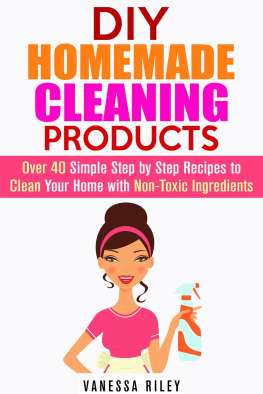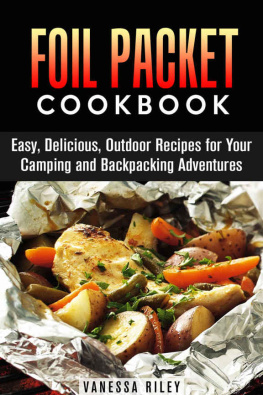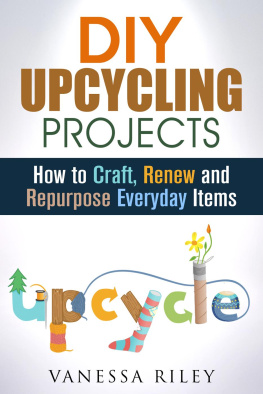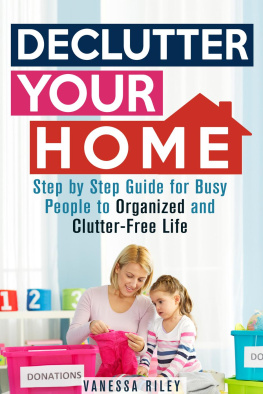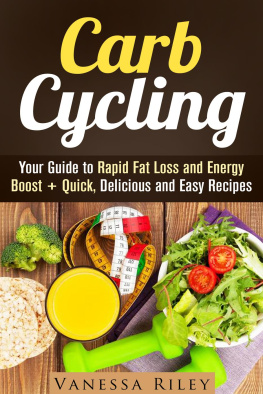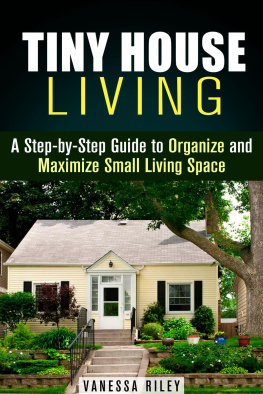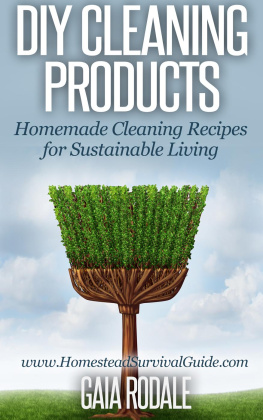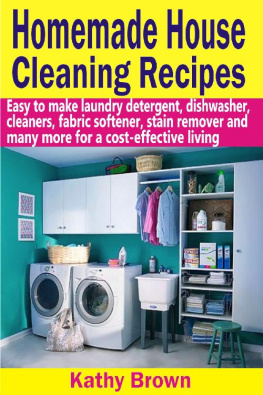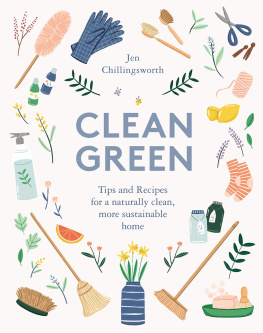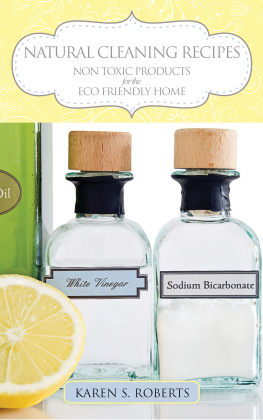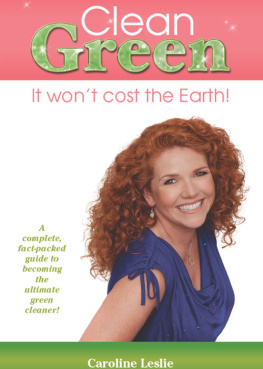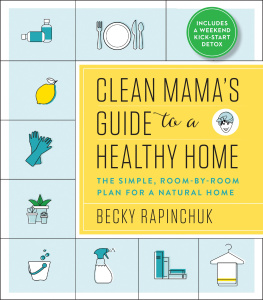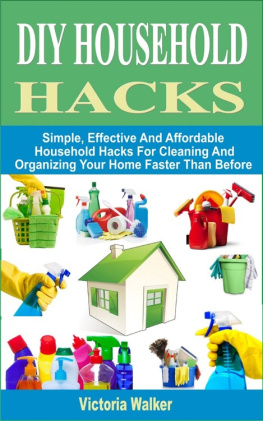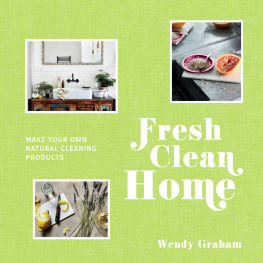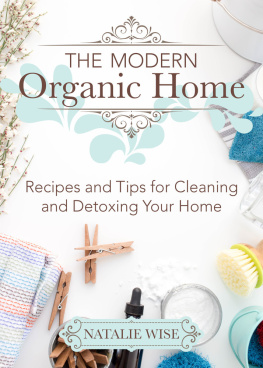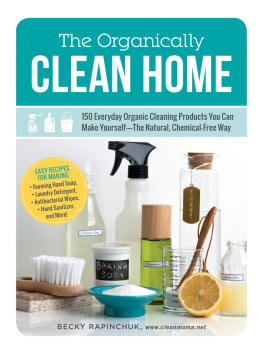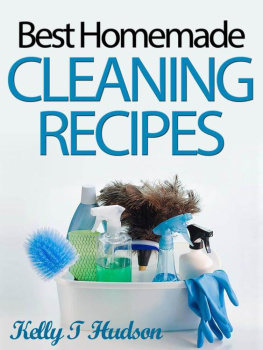DIY Homemade Cleaning Products
Over 40 Simple Step by Step Recipes To Clean Your Home With Non-Toxic Ingredients
Copyright Notice
Reproduction, duplication, transmission of this document in part or in whole is permitted only with written permission from the publisher. All rights reserved.
Respective brands and trademarks mentioned in this book belong to their respective owners.
Disclaimer
This document is geared towards providing summarization of information related to the topic. While all attempts have been made to verify the accuracy of the information, the author does not assume any responsibility for errors, omissions, or interpretations of the content. The information is offered for informational or entertainment purposes only. If professional advice is necessary, a qualified legal, medical, financial or another respective professional should be consulted. The reader is responsible for his or her own actions. The publisher does not accept any responsibility or liability arising from damages or losses, real or perceived, direct or indirect, resulting from the use of this information.
Table of Contents
Introduction
W e all want our homes to be clean, dust free, healthy places to come home to and to raise our families in. These days when we go to the store we are shown a variety of products to deal with every home cleaning eventuality. Special kitchen cleaner, bathroom stain remover, tile cleaner, toilet sanitizer, coffee stain remover, wine stain remover and many, many more. Do you really need to spend 100s of dollars to keep your home to a reasonable standard?
The answer is no, you dont and, in truth, when you check the ingredients on all these cleaning agents you realize that you are bringing a lot of potentially dangerous products into your home. Did you know that if your dog or cat has an accident on your kitchen floor you should never clean it with bleach? The chemical reaction between the bleach and the ammonium in the puddle can cause toxic fumes to be emitted into the room. In doing something as simple as cleaning up a little accident you could be putting your children at risk.
The cleaning products available on the shelves of the grocery store are not designed with the health of your family in mind. Sure, they meet minimum standards as set by the government but they are also designed to maximize profit and therefore frequency of use. They are stuffed full of chemicals which you and your family will breathe in long after they have been used in the home. Many cleaning products have been shown to have potential adverse effects on the endocrine (hormone) system and overexposure can lead to hormone imbalances which can effect everything in your life from how much sleep you get or how irritable you are to weight problems or even fertility issues. The truth is a clean home does not need to smell of anything other than fresh air. Did you know that the EPA (the American Environmental Protection Agency) has stated that the home environment can actually have 100 times the pollution that the outdoors has? This shocking fact is all down to the use of chemical cleaning agents in small enclosed spaces.
You may have been conditioned to think that your home is only clean if it smells clean but how many of us actually know what clean smells like. For the product companies it is a combination of bleach or other chemicals with a fake scent such as lemon fresh, ocean mist or even new baby.
Luckily it is actually very easy to make your own, safe, cleaning agents in your home. This book is stuffed full of advice including more than 20 different recipes that you can make in just a few easy steps. Most recipes call for no more than 4 or 5 ingredients at the most almost all of which are available from your local drug or grocery store. Because homemade cleaning agents are not stuffed with preservatives they have a much shorter shelf life than commercial brands. We have, therefore, designed the recipes in small quantities. This has the added benefit that you can try out a full range of recipes to see what works best for you.
Chapter One: Advantages of Homemade Cleaning Products
I n this chapter, you will learn:
- Problems caused by commercial products
- Why homemade products are better for your health and wallet
The problem with commercial cleaning products
N obody wants to be the person whose home friends avoid because it is dirty, messy or a downright health hazard. Most of us (at least those of us who have left college) take pride in having a clean and well-organized home.
Sadly the array of different cleaning products on sale can be bewildering, and it can seem as though you need to invest in 5 different sprays, pastes and scrubs for each room in your home, not only that but the very best cleaning products seem to cost, and cost big!
Many cleaning products contain what are known as volatile organic compounds (VOCs) that can cause irritation to the eyes, nose and throat. These can exacerbate asthma and other breathing difficulties or respiratory illnesses. Even if you, your family and children do not suffer from asthma or a similar respiratory problem cleaning products can cause difficulties.
When we clean our homes we inevitably leave residue of products behind. As the day progresses we touch the clean surfaces, transferring some of the residual chemicals to our skin, as the day warms up the chemicals evaporate from the cleaned areas and persist in the home atmosphere waiting to be breathed in. Sure these things are marketed as having met minimum safety standards but in the US and many other countries these are worryingly low. The average American is exposed to 25 gallons of toxins in the cleaners they use in their home and many do not even know what toxins they are exposed to as there is no legal requirement to list the ingredients.
Many cleaning products contain bleach, others contain ammonia. You have to read the labels on the bottles very carefully to make sure that you do not mix them (or use a bleach-based cleaner to deal with a pets little accident) as the gas created from mixing these two compounds is extremely toxic. Some chemicals are known to be able to create carcinogens when mixed with others. Common offenders are terpenes from orange and lemon oils which mix with ozone at ground level to create carcinogens. Other compounds such as phthalates which are used in fake fragrances can mess with your hormone system leading to a variety of problems, including, heartbreakingly for some, infertility.
Its not just the immediate human effects that we need to be mindful of. Many chemicals are used then cleaned away with water that enters the drains and subsequently the water supply. Toxins in the water can, therefore can affect our rivers, oceans and wildlife.
It is possible to buy so-called green cleaners and a number of manufacturers have jumped on the ecological bandwagon. These products, however, are even more expensive than the ordinary household chemicals that the consumer is aiming to replace. Furthermore it can be difficult to know whether the products are intrinsically safe. The companies avoid using products that are known to have a toxic effect but some do use products whose long-term effects have yet to be proved.
A simple, homemade, fix!
C ommercial cleaning agents have a bewildering array of ingredients in them, they are, quite simply stuffed full of chemicals. Take all the cleaning agents in your home and put them together and you will have a virtual science lab that will enable you to poison a water supply or even provide some of the key ingredients needed to build a bomb! Who wants to expose their family to that? If you look at the ingredients list for homemade shampoo most of our recipes use less than 4 organic, natural ingredients. This just shows you how much unnecessary rubbish is packed into commercial preparations.
Next page
